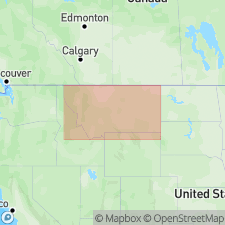
- Usage in publication:
-
- Big Hole River gravel
- Modifications:
-
- Named
- Dominant lithology:
-
- Gravel
- AAPG geologic province:
-
- Montana folded belt
Summary:
Named as an informal stratigraphic unit term for exposures along the Big Hole River between Twin Bridges and Glen, Beaverhead Co, MT in the Montana folded belt province. No type locality designated. Consists of stream-washed gravel and associated debris flows. Forms hills up to 200m high along the margins of the Pioneer and Highland Mountains, Caps high-level surface in the Ruby Mountains. Caps an irregular surface cut on rocks ranging in age from Archean to Tertiary. Buries hills of Eocene volcanics, Quadrant Quartzite, Archean rocks. Can be as much as 200 m thick. Thins to about 20 m in Sweetwater Creek area. Consists mostly of coarse-grained conglomerate. Grain size varies from sand and pebbles to boulders and blocks up to 10 m in diameter. Clasts vary from grain- to matrix-supported in coarse-grained sand. The largest and most angular blocks occur near base. Boulders occur in trains deposited in old stream channels. On east side McCartney Mountain, blocks of granite red boulders of "Beaverhead Conglomerate", and Archean gneiss are found. On east flank of the Hogback, boulder found from the Phosphoria, Dinwoody, and Quadrant Formations. Downslope angular boulders also came from Belt Supergroup, Archean metamorphics, Cretaceous granite, Eocene volcanics, Mesozoic hornfels--all of which crop out in the Pioneer and Highland Mountains. Was transported as channelized debris flows and bedload. Thought to be a braid plain deposit. Deposited in an isolated basin in late Tertiary time sometime between 10 and 4 Ma. Depositional system map.
Source: GNU records (USGS DDS-6; Denver GNULEX).
For more information, please contact Nancy Stamm, Geologic Names Committee Secretary.
Asterisk (*) indicates published by U.S. Geological Survey authors.
"No current usage" (†) implies that a name has been abandoned or has fallen into disuse. Former usage and, if known, replacement name given in parentheses ( ).
Slash (/) indicates name conflicts with nomenclatural guidelines (CSN, 1933; ACSN, 1961, 1970; NACSN, 1983, 2005, 2021). May be explained within brackets ([ ]).

